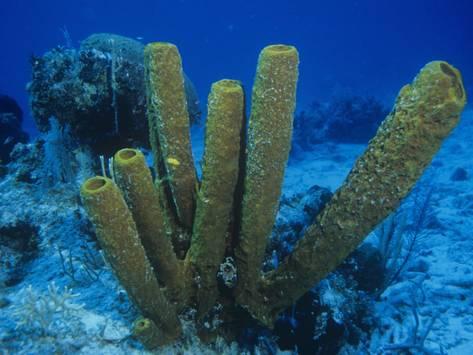
- Poriferans (Pore bearing animals) are the first multicellular animals.
- They are commonly called sponges because of their appearance.
- They are aquatic, mostly marine, rarely fresh water (e.g. Spongilla).
- They may be solitary or colonial.
- All adults are sessile attached to the substratum but their larva is motile.
- Body pores:
- Body is porous (provided with pores) i.e. ostia and
- Ostia, also called inhalant pores or inlet canals are small and many in number distributed throughout the body surface.
- Osculum, also called exhalent pore or outlet canal is a single large opening on the top of their bodies.
- Body of sponge has a large spacious cavity called spongocoel or paragastric cavity which opens through osculum at the top.
- Body symmetry:
- They are asymmetrical, some are radially symmetrical.
- They have cellular level of organization and cell-aggregated body plan.
- The whole body consists of a group of well differentiated cells.
- Body wall:
- They are diploblastic. i.e. body wall with 2 layers; outer dermal layer or pinacoderm, and inner gastral layer or choanoderm.
- Pinacoderm consists of pinacocytes and porocytes. Pinacocytes are flat and multinucleated polygonal cells.
- Porocytes are oval and uninucleated cells with intercellular pore called prosopyle.
- Choanoderm consitsts of only collar cells or choanocytes or flagellated cells.
- In between outer and inner layer, there is a mesenchyme, a non-cellular layer. It contains collagen fibers, spicules and amoebocytes.
- Almost all sponges possess an internal skeleton of tiny calcareous or siliceous spicules or of fine sponging fibers or of both.
- Mode of nutrition:
- They are filter feeder and holozoic and take solid food.
- Digestion is intracellular and takes place in food vacuole and chonaocytes.
- Circulation and excretion:
- Circulation takes place by wandering of amoebocytes.
- Excretion occurs through general body surface by diffusion and they are ammonotelic.
- Reproduction:
- Asexual reproduction takes place by budding and gemmule formation.
- They are hermaphrodite and protogynous (female reproductive organ maturing faster than male) animals.
- Sexual reproduction occurs by the production of ova and sperm.
- Development is indirect and larva (amphiblastula or parenchymula) is free swimming.
Classification of Porifera:
Phylum porifera is classified into three classes on the basis of skeleton or spicules they possess.
Class: Calcarea
- They all are marine, shallow and coastal water species.
- Body is vase shaped and comparatively simple in structure.
- They have a radially symmetrical body.
- Skeleton consists of calcareous spicules made up of carbonate of lime.
- Spicules may be monoaxon, triaxon, tetraxon.
- Canal system is Ascon or Sycon
- e.g. Sycon, Grantia, Leucosolenia.
Class: Hexactinellida
- They all are marine and deep sea species.
- Body is vase shaped or cylindrical.
- They are radially symmetrical.
- Skeleton consists of siliceous spicules which are triaxons with six rays.
- Canal system may be Sycon or Leucon
- e.g. Hyalonema, Euplectella
Class: Demospongiae
- They may be fresh water or marine.
- Their body is massive and asymmetrical.
- Canal system is Leucon type.
- Skeleton consists of Spongin fibers, siliceous spicules which are monoaxon and triaxon.
- e.g. Euspongia, Spongilla